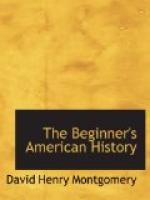What is said about the North and the South in the war? How long did the war last? What is said about it? What did President Lincoln do for the slaves? After a time what general got the command of all the armies of the North? Who became the chief defender of the South? Where were the last battles fought? What did the South do at last? What happened then? What did the success of the North do? What is said about slavery? What could the North and the South do? What was the saddest thing which happened at the close of the war? How did the North and the South feel about President Lincoln?
SINCE THE WAR.
263. How the North and the South have grown since the war; the great West.—Since the war the united North and South have grown and prospered[1] as never before. At the South many new and flourishing towns and cities have sprung up. Mines of coal and iron have been opened, hundreds of cotton-mills and factories have been built, and long lines of railroads have been constructed.
At the West changes equally great have taken place. Cities have risen up in the wilderness, mines of silver and gold have been opened, and immense farms and cattle ranches[2] produce food enough to feed all America. Three great lines of railroads have been built which connect with railroads at the East, and stretch across the continent from the Atlantic to the Pacific. Into that vast country beyond the Mississippi hundreds of thousands of industrious people are moving from all parts of the earth, and are building homes for themselves and for their children.
[Illustration: THE MEETING OF THE ENGINES FROM THE EAST AND THE WEST AFTER THE LAST SPIKE WAS DRIVEN[3] ON THE COMPLETION OF THE FIRST RAILROAD TO THE PACIFIC IN 1869.]
[Illustration: PILING SILVER BRICKS. (From the silver mines in Colorado.)]
[Illustration: HOW THEY USED TO SHOOT BUFFALO IN THE FAR WEST.]
[Illustration: INDIANS ATTACKING A STAGE-COACH IN THE FAR WEST FORTY YEARS AGO; BEFORE THE FIRST PACIFIC RAILROAD WAS BUILT.]
[Footnote 1: Prospered: to prosper is to succeed, to get on in life, to grow rich.]
[Footnote 2: Ranches (ran’chez): farms at the West for raising horses and cattle, or sheep.]
[Footnote 3: The last spikes (one of gold from California, one of silver from Nevada, and one made of gold, silver, and iron from Arizona) were driven just as the clock struck twelve (noon) on May 10th, 1869, at Promontory Point, near Salt Lake, Utah. Every blow of the hammer was telegraphed throughout the United States.]
264. Celebration of the discovery of America by Columbus; the unfinished pyramid; making history.—Four hundred years have gone by since the first civilized man crossed the ocean and found this new world which we call America. We are now about to celebrate that discovery made by Columbus, not only in the schools throughout the country, but by a great fair—called the “World’s Columbian Exposition”—to be held at Chicago; and we shall invite all who will to come from all parts of the globe and join us in the celebration.




